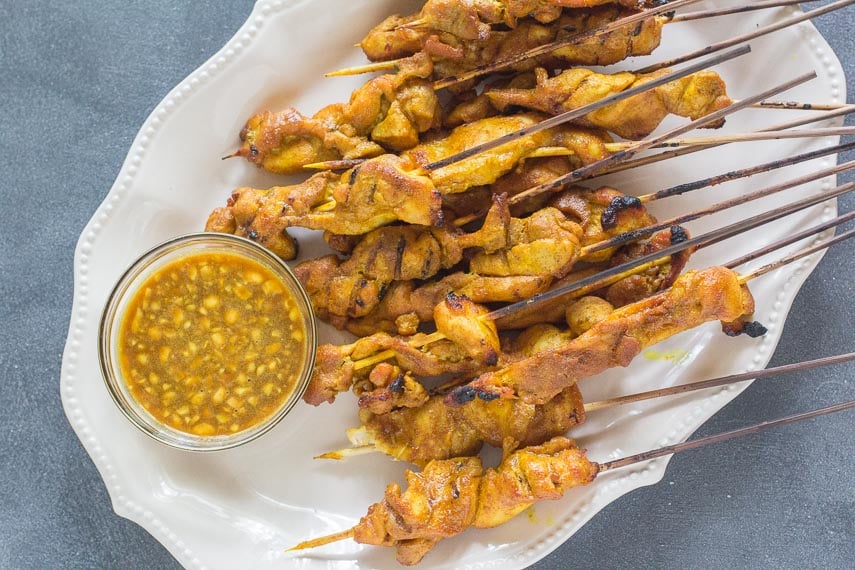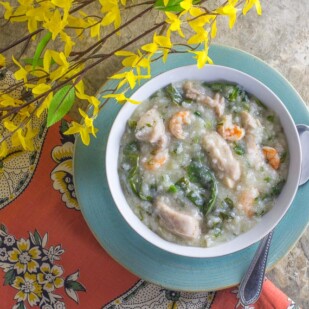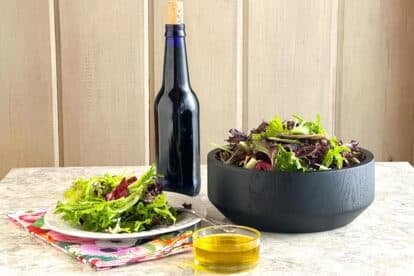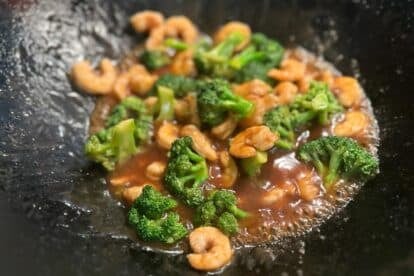FODMAP IT!™ Singapore Chicken Satay via Milk Street
I have been a longtime fan of Cook’s Illustrated and even wrote and developed recipes for them a long time ago (baked apples, oven-dried tomatoes, among others).
When Christopher Kimball started his new venture, Milk Street, I was intrigued.
This new magazine takes a unique global view to its recipes and stories and functions as much as an entertaining travelogue as it does a source of recipes to try, such as this Singapore Chicken Satay.
I have presented a Chicken Satay in my book, The Low-FODMAP Diet Step by Step, but that one was based upon one I have been making for decades, since my catering days, and it is very peanut-y.
This version of Singapore Chicken Satay does contain peanut butter, but it is a mere 1 tablespoon, and then there is a small amount of chopped peanuts, as well.
This version also differs in that it requires you to make two sauces: one as a marinade prior to cooking and another that is slathered on during cooking and also used as a dipping sauce.
The Milk Street approach, or rather their reporting of this traditional Singaporean dish, relies heavily on turmeric, ginger and sugar.
Yes, sugar!
It is integral and what encourages a nice char and caramelization.
The original also contained a fair amount of garlic, which we have replaced with Garlic-Infused Oil, preferably made with peanut oil, but any vegetable oil will do.
We like these hot, right off the grill (or out of the broiler), but they actually work barely warm as a passed hors d’oeuvres as well, which is what we used to do in our catering days.
Skewers: Bamboo or…
Don’t worry about the bamboo skewers getting charred. They do, a bit, but it isn’t a big deal and adds to their “street food” charm, in its own way.

FODMAP IT!™ Singapore Chicken Satay
This version of chicken satay is light on peanut butter but has tons of flavor from garlic-infused oil, turmeric and ginger.
Low FODMAP Serving Size Info: Makes about 20 kebobs; serving size 2 kebobs
Ingredients:
Marinade & Chicken:
- 1/4 cup (50 g) sugar
- 3 tablespoons Garlic-Infused Oil, preferably made with peanut oil, or other vegetable oil
- 1 tablespoon plus 1 ½ teaspoons peeled & grated fresh ginger
- 1 tablespoon plus 1 teaspoon turmeric
- 2 teaspoons kosher salt
- 2 pounds (910 g) skinless, boneless chicken thighs, cut lengthwise into 1-inch (2.5 cm) wide strips
- Bamboo skewers or thin metal skewers
Sauce:
- 1/4 cup (60 ml) hot water
- 1 tablespoon peanut butter, preferably no-stir creamy style
- 1/4 cup (60 ml) rice vinegar
- 1/4 cup (60 ml) low sodium soy sauce
- 2 tablespoons Garlic-Infused Oil, preferably made with peanut oil, or other vegetable oil
- 2 tablespoons sugar
- 2 teaspoons peeled & grated fresh ginger
- 1/2 teaspoon turmeric
- 1/4 teaspoon red pepper flakes
- 2 tablespoons dry-roasted peanuts, finely chopped
Preparation:
-
For the Marinade: About 30 minutes to an hour before cooking time, whisk together the sugar, Garlic-Infused Oil, ginger, turmeric and salt in a large nonreactive bowl. Add the chicken and toss well to coat. Allow to marinate for about 30 minutes to 1 hour.
-
Meanwhile, Make the Sauce: Whisk together the hot water, and peanut butter until smooth in a nonreactive bowl. Whisk in vinegar, soy sauce, Garlic-Infused Oil, sugar, ginger and turmeric. Pour off about ½ cup (120 ml) and add the peanuts to that portion and set aside to use as a dipping sauce. Thread each piece of chicken onto a skewer, discarding the marinade.
-
Prepare your wood or propane-fired grill to a medium heat, or preheat your broiler to high with a rack about 4-inches (10 cm) below. In this case line a sheet pan with aluminum foil (for easy clean up) and place a rack on top.
-
Grill or broil the chicken satay, turning often and brushing with the reserved sauce (without the peanuts). Total cooking time will be about 7 or 8 minutes. The chicken should be cooked through, there should be some char marks here and there, but don’t overcook. Satay is ready serve with peanut dipping sauce.
Notes:
Tips
- You can use skinless, boneless chicken breasts for this recipe, in the same amount, but the satay will cook a bit quicker and not be quite as juicy.
Nutrition
All nutritional information is based on third-party calculations and should be considered estimates. Actual nutritional content will vary with brands used, measuring methods, portion sizes and more. For a more detailed explanation, please read our article Understanding The Nutrition Panel Within Our Recipes.
Low FODMAP Recipes Created Just For You!
We take low FODMAP recipes seriously at FODMAP Everyday®. That’s why Dédé oversees our Test Kitchen and makes sure that each and every recipe works – and is low FODMAP following the most up-to-date science.
Read our article How Are Low FODMAP Recipes Created? for more in-depth information.
Rest assured that you will not find more trustworthy or delicious low FODMAP recipes anywhere – several hundred and counting.
FODMAP Everyday®Low FODMAP Recipes At A Glance:
- FODMAP Everyday®is accredited by FODMAP Friendly.
- Dédé is low FODMAP trained by Monash University.
- Dédé is also individual accredited as a recipe developer and FODMAP educator by FODMAP Friendly.
- We maintain our own professional Test Kitchen.
- Dédé has over 30 years of professional recipe development experience, including her stint as a Contributing Editor for Bon Appetit magazine and has written 17 cookbooks.
Come Join Our Low FODMAP Recipe Community!
Use Our Exclusive Recipe Filter To Find The Low FODMAP Recipe You Are Looking For Today!










The receipe was delicious. Low Fodmap doesn’t meant tasteless. I am so glad I found this wedsite.
THAT is our goal! Thank you for letting us know we are helping you! Please share with anyone you think will enjoy our recipes.
I swapped rice vinegar for apple cider vinegar and this was a very runny, very vinegary sauce that didn’t taste very peanutty. Was the ACV where I went wrong?
Hi Liz, this sauce is not thick like our Garlicky Peanut Sauce. Also, what kind of peanut butter did you use? I like the creamy no-stir styles, as recommended in the recipe, that have palm oil. They have smoothness and body.
Sorry, I just posted again, I didn’t see my original post come up :\ I used smooth, no added salt or sugar peanut butter. I didn’t use low sodium soy sauce though, just the standard one. I was using it to make a variation on pad thai but it was just too vinegary.
Well, the sauce is its own thing and it does have a pronounced acidic, vinegary flavor profile! It is not a pad Thai sauce by any means.Use our Pad Thai recipe for that.
Hi, I tried the sauce recipe, swapping rice vinegar for apple cider vinegar, and it was very runny and very vinegary. I added another tablespoon of peanut butter and heated it up to thicken, but it still tasted more vinegar than peanut. I got all quantities right, was the ACV where I went wrong? 🙁
Does the fat content include if you are using the peanut sauce or without? I’m wondering what the fat content is for just the chicken…
Hu Hunter. The recipe is calculated with the sauce. There is no way to parse out just the chicken. We also look at the nutritional information as approximate. Please read MORE HERE about the system. You could take the ingredients that you are interested in and put them through a nutritional calculator that you can find on line such as Nutrition Data.
This was delicious! I didn’t use skewers – just cut the chicken into bite sized pieces and cooked them in a pan. Definitely my favourite low-fodmap meal so far! I’m so glad I stumbled across these recipes.
Welcome aboard Sally! Thank you so much for Commenting and letting us know your experience – it will help others, too.
I’m making this for the first time. Already smelling lovely. I’m in the Uk and all our dry roasted peanuts have onion and garlic powder in. Can these still be used?
I’m in the elimination phase
Hi there. No, that would not be recommended. Use raw then as an alternative. Toast them a bit if you want to take the time. Or if you can find oil roasted that are plain.
Quick Question: Good morning, Dede. I know I’m late to the Satay party by a couple of years but I was craving it and popped on to see if you had a low FODMAP version. As always, FOPMAP Everyday did not disappoint!
I have a question, though. The stove (gas) in my apartment has the broiler separate, below rather in the oven (like the old gas stoves from times of yore). I pull the drawer out, put the food in, slide the drawer back, and keep my fingers crossed. I laid down on the floor to check the clearance under the element and the flames will definitely not be four (4) inches above the chicken. If I use the oven, what temp/timing do you suggest? Or, should I abandon all satay hope? Thank you.
Your note gave me a chuckle. Your dedication is admirable. I was picturing you laying down on the floor in the kitchen. I know exactly what kind of stove and broiler combination you’re talking about. I would still try the brew broiler and just monitor it every 30 seconds or so and see how it goes. Let us know
Will do! Thank you so much for the snappy response; I really appreciate it. I will get to my menu planning now!